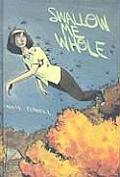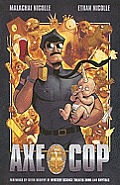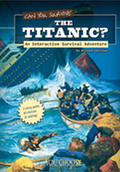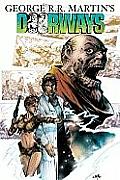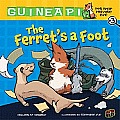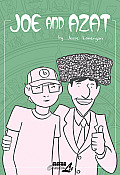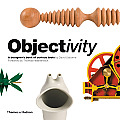Link to this review in the form of a comic strip by geneambaum tagged graphic novel • coming of age
Link to this review by dawnrutherford tagged graphic novel • superhero • humor
What does justice look like to a five-year-old? An axe-wielding cop who has no hesitation to do whatever is necessary to take down the bad guys, even if it means decapitation, poison, feeding them to dinosaurs, or knocking them on the head in their sleep.
Why I picked it up: While at Emerald City Comic Con I saw the two brothers who wrote it (the creator is five, the artist is twenty-nine) signing this book, and was reminded of all the good things I had heard about this ultra-violent comic.
Why I finished it: Though I wouldn’t normally have the stomach for the terrible things that happen in this book, the absurd kid-logic that binds this all together makes it sheer magic. That a cop could be so insanely brutal, yet clearly pure and good at the same time is an ironic juxtaposition every small boy holds in his heart. It is a treat to see the rambling chaos of Malachai’s imagination captured in comics. Who else would create a sidekick that is part avocado, part unicorn?
I’d give it to: Edith who might find herself with milk shooting out her nose when she reads Ask Axe Cop, the least helpful advice column on the planet.
Link to this review by flemtastic tagged history • chapter book
Both books blend facts and historical accuracy with the ability to make decisions about what happens to a character trying to stay alive. In Can You Survive the Titanic you can choose to be a first class passenger, a medical worker, or a third class passenger, and then attempt to survive the sinking (two-thirds of the passengers didn’t). In Can You Survive Antarctica you can try to survive temperatures up to one hundred degrees below zero fahrenheit as either a modern explorer or with Scott and Amundsen in the early 1900’s.
Each has a basic section at the end that explains what happened to the real people that experienced these extremes.
Why I picked it up: I was looking for quick reads for reluctant and low-ability readers, and these segmented, Choose Your Own Adventure-type books appealed to me because of their format.
Why I finished it: I found myself madly flipping back and forth to see if I would be killed by a rogue leopard seal, or if I would drown in third class under a wave of oil-fouled water.
I’d give it to: Wyatt, who would like the danger, because so many of the paths end in death. T.F., who has serious ADHD and would like the ability to stop and restart reading these without losing the narrative thread, because his attention waxes and wanes.
Link to this review by billba tagged romance • science fiction
An E.R. doctor encounters a strange, beautiful, and scantily clad woman with a metal device attached to her forearm. She bites the nose off a cop trying to restrain her, but the doctor’s bedside manner manages to calm her down. Then they travel to alternate universes.
Why I picked it up: I’d heard of the never-picked-up TV pilot Martin created in 1991 about alternate universes, one of my favorite sci-fi sub-genres. It always sounded good, and I loved the idea of turning it into a comic book, something that has become somewhat of a publishing specialty for IDW.
Why I finished it: The first world they visit has no petroleum products whatsoever, thanks to an entirely plausible scenario that starts with an oil spill off Australia.
I’d give it to: Kris Straub, an unrepentant fan of Sliders, which set an extremely low bar for episodic, alternate universe fiction (which this easily exceeds).
Link to this review by gigi tagged mystery • graphic novel
Sasspants is the guinea pig detective at Mr. Venezi’s Pets & Stuff. When Mr. V put up a help wanted sign (upside-down), Sasspants puts signs on all the cages to show which animal is in each cage so Mr. V won’t hire anyone new. Later some ferrets arrive and Hamisher (Sasspants’s assistant, a hamster) wants to see who they are and gets totally freaked out because they look like snakes with beards. Then someone changes the signs on the cages and Sasspants has to figure out who did it.
Why I picked it up: I love comics about ferrets. (Peach Fuzz is excellent.)
Why I finished it: I wanted to see which animal Sasspants would pick for his new detective assistant.
I’d give it to: Parker, because she would like the part when Hamisher mistakenly thinks he is guilty of changing the signs and locks himself in a hamster ball “jail.”
Link to this review by geneambaum tagged historical fiction • literary
Joe lives in Turkmenistan for two years as a Peace Corps volunteer. Azat is a dreamer who believes the U.S. is exactly like what he sees in the movies, and annoys Joe with detailed questions about English grammar. Then they become friends when Joe loses his passport in the market and Azat helps him get it back from a corrupt policeman. Azat wants to marry a girl from a rich family, become a rich businessman, and to find a girl for Joe to marry so that he’ll stay in Turkmenistan. But Joe plans on returning home at the end of his service.
Why I picked it up: Saw it on the shelf at my local library and decided to give it a try, since I know little about Turkmenistan.
Why I finished it: When Joe is in the market, he’s charged a high price for toothpaste because he’s a foreigner, even though he can speak the language. It makes him angry and suspicious of everyone, even the coffee vendor who isn’t trying to cheat him. I remember going through that when I lived in Korea, figuring out which shop owners I could trust and then giving them all my business.
I’d give it to: Gina, who told me how much I’d enjoy the travel/love story in To Timbuktu, because Joe is in Turkmenistan long enough to find the good, the bad, and a decent helping of the bizarre — the President writes a book, declares that if people read it they’ll go to heaven, and even launches a copy into space.
Link to this review by sarahhunt tagged nonfiction • coffee table book • art
Usborne collects useful items with shapes that inspire him and remind him of modern sculpture. The book presents his collection, arranged roughly by what the tools do: hitting, cutting, gripping, and more.
Why I picked it up: I shop at thrift stores where tools are arranged by what they are made of rather than what they do and I often stumble across mysterious items. I hoped the book would identify some of them. (And it did. One was a set of tomato-gripping tongs.)
Why I finished it: I loved the peeks into highly specialized tasks I got from cork washer cutters, a tonsillectomy guillotine, and a ceramic inhaler.
I’d give it to: Scott, a science fiction writer, because the alien-looking Earth tools would inspire him to create rich and detailed new worlds.
Link to this review by geneambaum tagged art • biography • picture book • graphic novel
Horton and Landowne meet in a subway station, looking at art, and ride the subway together, talking about life. Horton tells her about being given up for adoption and becoming homeless as a teen. The Center, a DSS facility, provided a roof and walls but was no refuge from the horrors of street life. He left and discovered he could live in the darkness below New York, in the subway tunnels.
Why I picked it up: This graphic novel had some buzz when it was published because Horton is a homeless artist. I met Landowne at a library conference a few years ago and talked to her about it, and I’ve reread it several times since then.
Why I finished it: The dark, black and white art is haunting from the endpapers (black on black images of empty subway tunnels) to the final page (a photo of Horton standing on a subway platform). It’s raw in a way that expresses Horton’s feelings and life, and the result is simply beautiful.
I’d give it to: Vicki, who was the first person to tell me about Mongolian street children. She’d enjoy it for the art and writing, and then she’d put it on the radar of the teachers she works with.
Link to this review by flemtastic tagged art • picture book • chapter book • graphic novel
Ben is a boy who doesn’t know his father, but wants to. After his mother passes away, he lives next door to his childhood home with his aunt. One night he sneaks over to his old house and finds some papers that might help him find his dad. When leaving the house, he is struck by lightning.
Fifty years earlier, Rose collected newspaper articles about a glamorous actress. But when she went to see the lady, it turned out that she was Rose’s mother, and she was not happy to see Rose.
Why I picked it up: It promised one hundred more pictures than The Invention of Hugo Cabret, which was filled with intricate pencil drawings unlike any I had ever seen. (At first I thought it was a sequel, but it has nothing to do with Hugo.)
Why I finished it: It was easy to identify with Ben’s hearing loss and subsequent struggles to communicate by sign and writing as I experienced his world silently, through the illustrations. Plus the two stories connected organically in a way I did not expect.
I’d give it to: My wife, Trish, who is hunting for her mother’s adoption records so she can find her grandparents, because she would empathize with Ben’s desire to know his roots.
